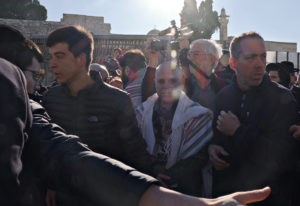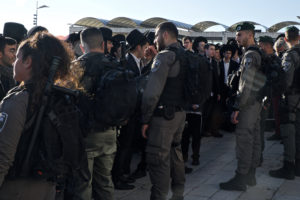Rachel Schwartz, 22, a student at the Conservative Yeshiva in Jerusalem, struggled against the mob with two older women. The three had come for a prayer service with Women of the Wall, the feminist, cross-denominational group of activists advocating for a separation of religion and state in Israel.
The Western Wall, also known as the Kotel, is a flashpoint for religious pluralism, or more specifically, Jewish religious equality. The Kotel is run by Orthodox Jewish standards, with a division between men and women by the wall. The site is managed by an Orthodox rabbi whose salary is paid for by the Israeli government.
And a nearby egalitarian plaza lacks government funding, oversight, or maintenance, part of a wider disparity between government funding of Orthodox institutions and liberal denominations like the Reform or Conservative movements.
Some right-wing Orthodox groups aren’t so keen on a separation between religion and state. So they bussed in thousands of teenage seminary girls to pack the women’s section of the Kotel.
Women of the Wall, celebrating its 30th anniversary and International Women’s day on the morning of March 8, would be squeezed into submission.
“I started to feel that this was not normal,” Schwartz said as she worked her way further into the women’s section, where roughly 150 members of WoW were trying to pray. “It literally felt like [the protesters] were trying to crush you.”
Not hiding their intentions, the seminary girls turned it into a game.
“There would be a group of 5-10 young women that would cluster together and just go ‘AHHHH’ and fall on you to push you towards the other direction,” Schwartz said. “The young women on the other side would be like, ‘don’t push, don’t push, why are you pushing’ and push you back towards the other group.”
When Schwartz made it to Women of the Wall, she realized that the protesters formed a ring of bodies to try and keep anyone from joining the group. On the edge of the ring, one of the women with Schwartz asked the girls to let her through because she wanted to join her family.
“‘Ohh, poor you, oh so sad for you, oh you want to go to your family!’” Schwartz recalled the girls yelling in a mocking voice, a moment she also recorded with her phone. “Then they fall and push you and it becomes a whole other scuffle of, ‘stop pushing, stop pushing, no you’re pushing, how dare you do this.’”
The mob was overwhelming, with many members of WoW crying from the stress. Near Schwartz, an American seminary girl had a panic attack. Protesters didn’t let the girl out until Schwartz yelled at them.
Alternately shoved, scratched, spit on, their hair pulled and, in at least one case, almost kicked in the head, Women of the Wall lasted only about 45 minutes before relocating from the women’s section of the Kotel to the egalitarian section further away.
“I’ve never been surrounded by so many people before,” Schwartz said. “Especially people who don’t want you to be there.”
Up and Down
From above they looked like ants. In the men’s section, the black of suits and white of tallitot. In the deformed, borderless women’s section expanded onto the main plaza, just the black of the seminary girls and an extra rowdy group of ultra-Orthodox men and boys.
A cliche, but also true: from a bird’s eye view, it was almost peaceful. And, with the Kotel, Golden Dome, Al-Aqsa mosque, Old City of Jerusalem, and Mount of Olives in the background, the morning could be nothing but historic. Here Babylonians and Romans had sacked Jerusalem and razed the first and second Jewish temples.
Now, here are the Jews, fighting one another.
I alternated between the view higher up in the Old City, and the chaos of the main Kotel plaza. Outside of the women’s section itself, most of the seminary girls were praying, swaying back and forth with faces in siddurim. Praying for the Women of the Wall, who they see as sinners blinded by modernity.
“I understand [Women of the Wall’s] feelings, that they’re going to fight for equality, but you shouldn’t test the waters in a place that has 2,000 years of tradition,” said Ephraim Unger, 22, a student at an ultra-Orthodox yeshiva in the Old City. “I feel they’re misguided,” he said, but “I’m not coming to think that they’re bad people.”
The interview was frustrating. On International Women’s day, on WoW’s 30th anniversary, I – a male journalist – was interviewing another guy. But I’d asked a number of seminary girls for an interview (they didn’t speak English), and I assumed that Unger was nonetheless representing the narrative of the protesters.
If anything, the men have long been the most violent part of WoW’s protesters. In the past, they have torn kippot, tzitzit, and tallitot off of non-Orthodox men who come to pray in support of WoW. They have forcibly taken Torah scrolls away from the female activists and burned prayerbooks.

Yizhar Hess (center) tries to make his way through a crowd at the Western Wall. (Photo by Lev Gringauz)
Minutes before talking with Unger, I witnessed a crowd of ultra-Orthodox men and boys (as young as 8 or 9 years old) attack Yizhar Hess, the executive director and CEO of the Masorti (Conservative) movement in Israel. They banded together, and, howling like football fans, barreled into Hess and the other Masorti members with him.
A video, later circulated on Facebook, showed Hess in the middle of the group, trying to put on his kipah and tallit while both were continually grabbed at by the protesters. Jeered at, yelled at, tackled, attacked. The Israeli police looked far out of their depth, themselves completely unsure of how to deal with the situation.
Down here, I felt goosebumps and an overwhelming sense of helplessness. How did we get here? I wondered. Surely this isn’t what so many Jews had died for. The shtetls had all been liquidated, and where had we ended up?
“I agree, it should not be violent at all,” Unger said, and I was surprised that that’s all he had to say, prodding him for more.
“I understand where the protesters are coming from, they think that the sanctity over here; it’s not something to play with,” he added. “It’s not a child’s matter that if you have your opinion, you should so easily go against things which people here [hold] as very holy to them.”
But then why show up and give Women of the Wall the attention?
“If we wouldn’t do anything, they would just be singing, and that’s not something which we think is appropriate for the sanctity of the place. There’s a line where you have to step down.”
The Power
After 45 minutes of chaos, and two members of WoW evacuated by paramedics, Schwartz joined the other activists in a congested single-file migration organized by the police.
The group relocated from the women’s section to Robinson’s Arch, an area next to the main Kotel area that hosts an egalitarian plaza, suspended above the archeological ruins of a broken Jerusalem and stone blocks that had been pushed by Romans off of the Temple Mount.
As they walked, many of the activists looking beaten and distraught, some in the group began singing Ozi v’Zimrat Yah, Vayahi Li Lishua. The song, in translation, means “my strength and the song of God will be my salvation.”
“We’re there to raise our voice, and [the protesters] know that,” Schwartz said. “When you’re singing Ozi v’Zimrat Yah, they go shhhh because they want you to not use your voice. We defy that. And I think that brings people closer together. That’s a story that doesn’t get told: What it means to raise your voice when people don’t want you to.”
At Robinson’s Arch, the group collected itself, eventually breaking out into dance while singing Ozi, and continuing with the rest of the morning service. I was there when the service ended, and the activists surprised me by singing Hatikvah, “the Hope”, the national anthem of Israel.
After that morning, still Hatikvah?
I waited for Lesley Sachs, the executive director of WoW, to finish recording a video before asking for an interview. She had already done a number of them and downed an entire bottle of water in one go before speaking.
“The reason that we are willing to go through what we went today…is because we have that hope and that conviction that we need to be part of the change” in Israel, Sachs said. “That’s Tikkun Olam. We’re religious people, Tikkun Olam is our mission. So, of course, we sing Hatikvah, because this is what keeps us going.”
The Winners and the Losers?
“We just lost, everybody lost,” said Rabbi Susan Silverman, a board member of WoW and a prominent Reform rabbi. “We moved out of necessity for our lives.”
Silverman had fallen down that Friday morning when the group was still in the women’s section of the Kotel, surrounded and closed in by seminary girls. She had almost been kicked in the head by one of them, until her daughter stepped in.
“I don’t know, would they consider it a success that we left that space?” she said. “Maybe. But wow, at what cost.”
Nonetheless, baby steps have been made over the past 30 years. When Women of the Wall first started, it was illegal for women to pray out loud at the Kotel, or to wear tallitot or tefillin (now legal).
The activists were regularly arrested until the Supreme Court ruled just a few years ago that the group was now part of the regular customs of

Police try to hold back ultra-Orthodox protesters at the Western Wall (photo by Lev Gringauz)
the Kotel, and deserved police protection. Reading from the Torah, however, is still illegal in the women’s section.
And the police don’t always cooperate. For their 30th anniversary, WoW spoke to the police multiple times to warn of potential violence, but come the morning of March 8, the group says it was abandoned.
For now, the fight continues, and so do the prayer services, month by month, bit by bit. But Silverman says the nature of Israel could change in an instant.
“Right now, we have an election coming up, and people have to choose,” Silverman said. “Are we going to grow into a theocracy, because our government and the people in power are too concerned with their own control and their own power to risk losing a coalition over it?”
Through the frustration, Silverman holds on to hope and a brighter vision of Israel. “I see Start-Up Nation as a theological identity,” she said. “We’re God’s partners in making the world better.”

